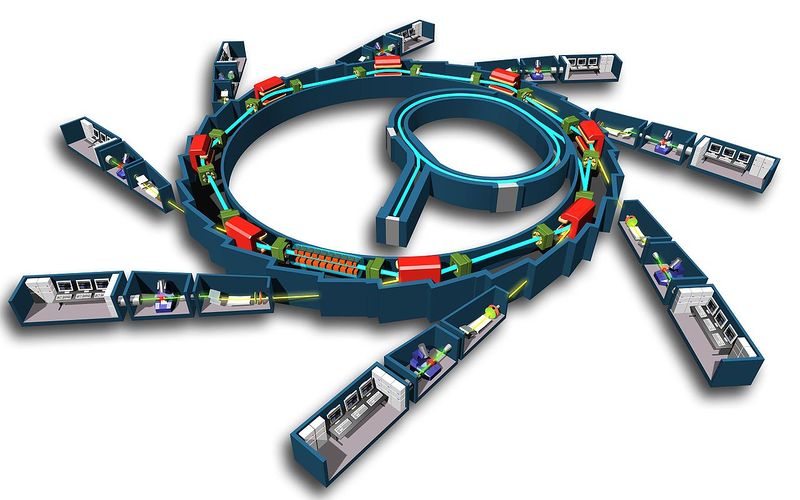Synchrotron
A synchrotron is a particle-accelerator used to generate intense beams of x-rays, which are then used to conduct a variety of scientific experiments. A synchrotron is a cyclic electron-accelerator; the high-energy electrons are then used to generate x-ray beams. Roughly, the synchrotron features a central storage ring, within which electrons orbit at high velocity. Along the ring, magnets are used both to confine the beam, and to steer it along the circular track. An accelerated charge will emit electromagnetic (EM) radiation. Applying a magnetic field to the circulating electrons will cause them to emit EM radiation: due to their high-energy, the emitted photons can be in the x-ray regime.
Thus, along the circular orbit, tangential x-ray beams are generated. These beams are directed through ports in the shield-wall, and thus into a particular beamline (the electron beam, meanwhile, is curved away and does not enter the beamline path). The beam is typically conditioned using various x-ray optics. For instance, a monochromator can be used to select a single x-ray wavelength, curved mirrors can be used to focus the beam, etc. A given beamline will have one or more endstations, with equipment (optics, sample holders, detectors) to enable a particular experiment. Synchrotrons typically have different beamlines optimized for different experiments: diffraction, macromolecular crystallography, SAXS, GISAXS, etc.
Synchrotrons are large, expensive facilities. They generate x-ray beams of a brightness that vastly surpasses what is available on a labscale instrument. Synchrotron beams are generally much higher-flux, and also have lower divergence (improving resolution), better energy resolution, and can have high coherent flux (for use in coherent experiments: XPCS, coherent scattering, CDI, ptychography, etc.).
Sources
A synchrotron can have different kinds of magnets, which act as sources of the high-flux beams. A given synchrotron is typically optimized to give high-flux for a certain range of energies; however this range can be extremely broad (e.g. a synchrotron can have beamlines across the IR, VIS, UV, x-ray, and into hard x-rays). However, each particular beamline will use a particular source for its beam, and this source is typically optimized to yield highest flux for only a certain range of energies.
Bending Magnets
The magnets used to deflect the beam around the ring can be used to generate beams. Alternatively, a variety of multipole magnets can be used to induce an oscillation of the electron-beam, thereby generating x-rays. These sources are called bending magnets (BM), wigglers, etc.
Insertion Devices
Along straight-sections within the storage ring, one can install a device that includes a large number of magnet poles that alternate in direction (e.g. 10 to 30 periods). When passing through such a device, the electron beam will thus oscillate back-and-forth repeatedly. If properly aligned, these oscillations are in-phase, and their flux thus adds together coherently. The end result is a very high-flux beam. These are called insertion devices (ID) or undulators, and are typically the highest-flux beamlines available.
Radiation
The central storage ring generates significant amounts of radiation. The electrons themselves are high-energy, and emit EM radiation as they are magnetically confined and steered. Moreover, emissions of electrons or photons from the ring can generate secondary radiation from components near the ring. For instance, Bremsstrahlung is the photon-radiation that arises from the deceleration of electrons, which can occur in a synchrotron when high-energy electrons impact beamline equipment or the shield-wall.
The storage ring in a synchrotron is held within a thick storage-wall, which blocks the radiation. The beamlines are then housed within shielded hutches, which prevent exposure to the x-ray beams, or any secondary radiation thereof.
Literature
- Edgar Weckert The potential of future light sources to explore the structure and function of matter IUCrJ 2015 2 (2). doi: 10.1107/S2052252514024269
